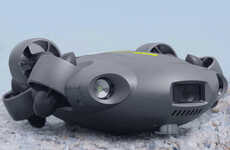
The Fish-Like Tai-Robot-Kun
Noora Abu Eitah — July 27, 2008 — Art & Design
References: pinktentacle
“Tai-robot-kun,†is an underwater survey robot that looks like a giant fish. The robot was developed by the University of Kitakyushu.
The giant fish weighs 7 kgs, and is made from a silicone body, covered in realistically hand-painted scales. It also features a unique propulsion system that allows its tail to generate realistic swimming movements.
I am glad that this fish robot actually serves a purpose that will benefit us all, rather than it being designed to solely showcase human absurd capabilities. I just hope this technology doesn't get to the wrong hands.
The giant fish weighs 7 kgs, and is made from a silicone body, covered in realistically hand-painted scales. It also features a unique propulsion system that allows its tail to generate realistic swimming movements.
I am glad that this fish robot actually serves a purpose that will benefit us all, rather than it being designed to solely showcase human absurd capabilities. I just hope this technology doesn't get to the wrong hands.
Trend Themes
1. Underwater Survey Robotics - The development of fish-like robots for underwater survey presents an opportunity for disruptive innovation in ocean exploration and maintenance.
2. Realistic Fish Robotics - The creation of realistic fish robots using silicone bodies and hand-painted scales offers potential for disrupting the fishing industry and marine wildlife observation.
3. Propulsion System Innovation - The propulsion system of the Tai-robot-kun robot fish could spark a wave of disruptive innovation in underwater vehicle engineering.
Industry Implications
1. Oceanography - The development of underwater survey robots could revolutionize oceanographic research and exploration.
2. Fishing - The creation of realistic fish robots could disrupt the fishing industry by providing alternative methods for seafood production and fishing research.
3. Marine Conservation - The use of underwater survey robots offers potential for disrupting marine conservation by enabling better monitoring and conservation efforts.
3.3
Score
Popularity
Activity
Freshness















